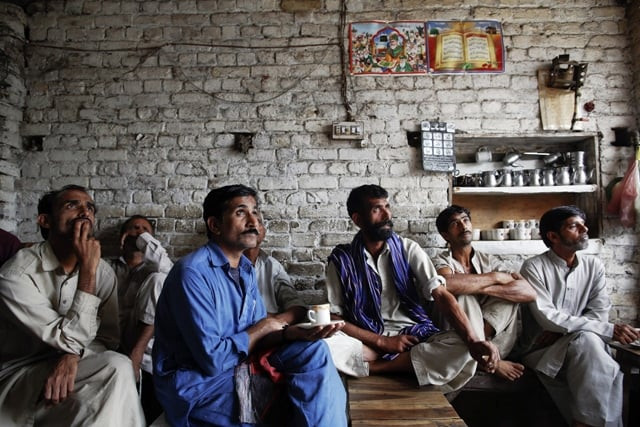Result card
The PML-N, set to take, at least, 130 seats in the National Assembly (NA), will be forming the next government.

People in a traditional tea shop wait in anticipation of the election results..
PHOTO: REUTERS

But first, let’s speak of the two major parties — the ones which since the 1980s have dominated the political scene. Their fortunes contrast vastly. The PML-N, set to take, at least, 130 seats in the National Assembly (NA), will be forming the next government. It has the numbers to do so on its own, though it may opt to take a few partners on board, perhaps to demonstrate federalism — given that its strength was most evident in Punjab. The PPP, which claimed nearly 100 NA seats last time round, has suffered huge losses, retaining its hold only in Sindh. With some 32 seats so far, it lags behind the PTI which has taken 36 so far. Big names for the PPP have toppled: former prime minister Raja Pervaiz Ashraf, two sons of Yousaf Raza Gillani, ex-ministers Qamar Zaman Kaira, Firdous Ashiq Awan and others. The arrow has missed its target — and people have demonstrated a lack of faith in those who for five years held the bow, in a clear message from the electorate that if parties don’t deliver on governance, they will not be voted in. The fate of the ANP has been worse still. It has been reduced to a few seats in the K-P Assembly, claimed none in the centre so far and saw leaders such as Ghulam Ahmed Bilour fall to Imran Khan. The PML-Q, too, has vanished as a force. The MQM keeps its hold on Karachi, but the rigging problems seen there, with the active involvement of political mafias, raise a whole set of problems. Re-polling has been ordered by the Election Commission of Pakistan in NA-250.
We have seen provinces go their separate ways: Punjab for the PML-N, Sindh for the PPP, K-P for the PTI, while the scenario from Balochistan still continues to emerge, with the BNP and pro-nationalist forces seemingly faring well so far. The impact of this diverse response too needs to be assessed, notably in the light of our struggles as a federation. The need for a coalition government may come up there and possibly also in the K-P.
People then have voted on the whole for change. This has already been widely acknowledged, by the more mature of the losing leaders too. The majority of citizens naturally want an end to inflation, to economic disarray, to misgovernance, to lawlessness and to terrorism which undoubtedly had an impact on these elections, preventing the ANP, the PPP and the MQM from campaigning as they would have hoped to. We can only wonder how much impact this has had on the final result. It is also to be seen if the new order, to be led by Mian Nawaz Sharif, serving his third term as prime minister, can deliver on all the promises made by his party and come up to expectations. It seems likely that we will see a switch in the stance on militancy, with the PML-N talking of negotiations with the Taliban. There is also the question of how the party will deal with the establishment. But these are matters for the future. We will have five years to assess them. Right now, the question is whether the results have a direct impact on parties, with much talk of rifts within both the PPP and the ANP, and also how the new entrants to parliament will cope with the challenges of real time politics. The weeks and months ahead will be interesting ones to watch as we see our future taking shape.
Published in The Express Tribune, May 13th, 2013.














COMMENTS
Comments are moderated and generally will be posted if they are on-topic and not abusive.
For more information, please see our Comments FAQ